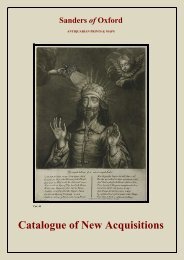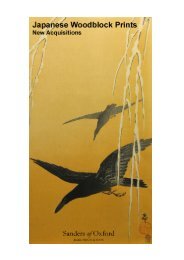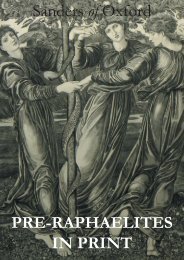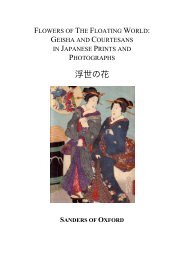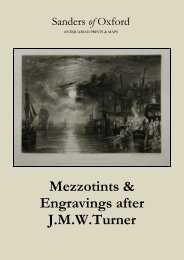catalogue text.indd - Sanders of Oxford
catalogue text.indd - Sanders of Oxford
catalogue text.indd - Sanders of Oxford
Create successful ePaper yourself
Turn your PDF publications into a flip-book with our unique Google optimized e-Paper software.
Durand’s red stamp on verso.<br />
[30122]<br />
£300<br />
6. [Saint Jerome in his Study]<br />
Héliogravure<br />
Charles Amand-Durand after Albrecht Dürer<br />
c.1870<br />
Image 186 x 244 mm, 199 x 256 mm<br />
unmounted<br />
Saint Jerome in the Study, originally engraved in 1514,<br />
is one <strong>of</strong> Albrecht Dürer’s most celebrated images. It<br />
depicts the hallow as he works upon ‘The Vulgate’; a<br />
fourth-century Latinate version <strong>of</strong> the Bible that Pope<br />
Damascus I had commissioned. The iconography <strong>of</strong> the<br />
cardinals hat and the docile lion identify the Saint, whilst<br />
other images <strong>of</strong> Vanitas litter the scene. A skull rests on<br />
the windowsill; a crucifix resides on the desk, and an<br />
hourglass adorns the wall.<br />
Charles Amand-Durand’s reproduction <strong>of</strong> Dürer’s engraving<br />
constitutes an interesting example <strong>of</strong> prints after<br />
the Old Master. Like others before him, Armand-Durand<br />
attempted to democratise the art industry by reproducing<br />
the works <strong>of</strong> famed artists which were hidden in the<br />
repositories <strong>of</strong> the French National Library, or in the<br />
ownership <strong>of</strong> private collectors. His main series <strong>of</strong> facsimiles<br />
after Old Master prints began in 1869. They were<br />
usually published in portfolios, with accompanying <strong>text</strong><br />
by Georges Duplessis. A high quality photograph would<br />
have been taken <strong>of</strong> Dürer’s original work. The negative<br />
was then exposed onto a gelatin covered copper plate, and<br />
etched with acid. At this point, the photogravure would<br />
have been mechanically printed, but the technique <strong>of</strong> the<br />
héliogravure differs in that Amand-Durand continued to<br />
etch parts <strong>of</strong> the plate himself, and printed the works by<br />
hand. Somewhat paradoxically, Amand-Durand’s works<br />
have become as esoteric as the artists that he sought to<br />
democratise.<br />
Condition: Slight toning to the sheet. Contains Amand-<br />
7. [The Cornfield]<br />
Mezzotint<br />
David Lucas after John Constable<br />
London: Republished Feb.y 15, 1853, by Thomas Boys<br />
(<strong>of</strong> the late Firm <strong>of</strong> Moon, Boyd & Greaves,) Printseller<br />
to the Royal Family, 467, <strong>Oxford</strong> Street - Paris.<br />
E.Gambart & C. 9 Rue d’Orleans au Marais,-Depose.<br />
Originally Published July 1.1834.<br />
Image 487 x 565 mm, Plate 515 x 683 mm, Sheet 606 x<br />
736 mm<br />
framed<br />
First exhibited at the Royal Academy in 1826, Constable’s<br />
‘The Cornfield’ became one <strong>of</strong> the artist’s<br />
most celebrated works. It was reproduced in mezzotint<br />
by David Lucas in 1834, and sold by J. McLean and<br />
Hodgson, Boys and Graves, and Rudolph Ackermann.<br />
This print, however, derives from a posthumous collection<br />
<strong>of</strong> Constable’s works entitled ‘English Landscape<br />
Scenery,’edited by H.G. Bohn and published by Thomas<br />
Boys in 1853. The series consisted <strong>of</strong> forty mezzotint<br />
engravings on steel plates; all <strong>of</strong> which were produced by<br />
Lucas.<br />
The Cornfield depicts Fen lane as it leads from East<br />
Bergholt towards Dedham; a village in the borough <strong>of</strong><br />
Colchester. A flock <strong>of</strong> sheep are followed by a dog as the<br />
path winds towards figures active in a cornfield. A boy,<br />
prone and with his face on the surface <strong>of</strong> a stream, slakes<br />
his thirst. The church in the distance is thought to have<br />
been an invention on Constable’s part.<br />
Inscription content: ‘Painted by John Constable. En-





